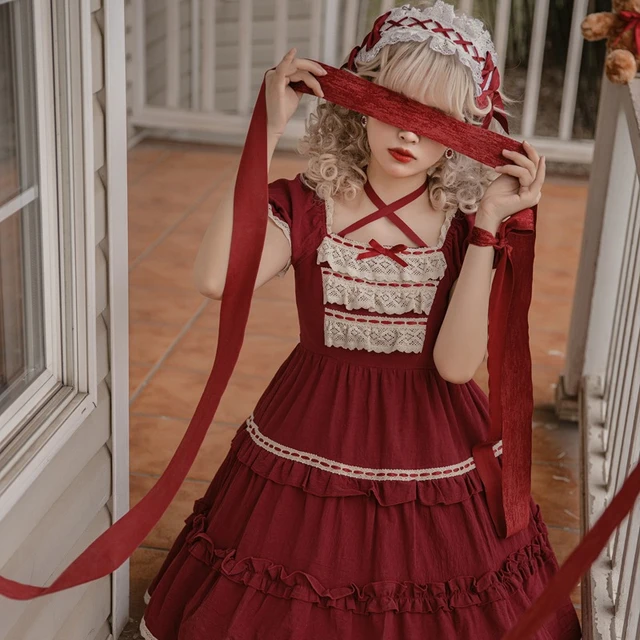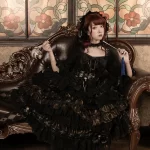The Origins of Lolita Fashion
The term ‘vintage lolita dress’ hints at a rich history. Lolita fashion began in Japan during the 1980s. Its roots trace back to the youth culture of Harajuku, Tokyo. At its core, Lolita style blends Victorian-era fashion with Rococo period elements. This creates a unique, whimsical look. Inspiration also came from gothic and punk styles blending in with historical costumes. Early adopters of Lolita fashion sought ways to stand out. They wanted to resist mainstream trends that dominated Japan’s fashion scene.
The name ‘Lolita’ stirs much debate about its origin. Some suggest it comes from Vladimir Nabokov’s novel, though the style and book are not related. Others believe the name arose from the Spanish term ‘Lolita’, which refers to a young girl. What is clear is the impact of Lolita fashion. It has sparked a global following. Enthusiasts embrace the style’s attention to detail and the pursuit of beauty. The vintage lolita dress pays homage to the style’s historical influences. It reflects a longing for a bygone era of elegance and decorum.
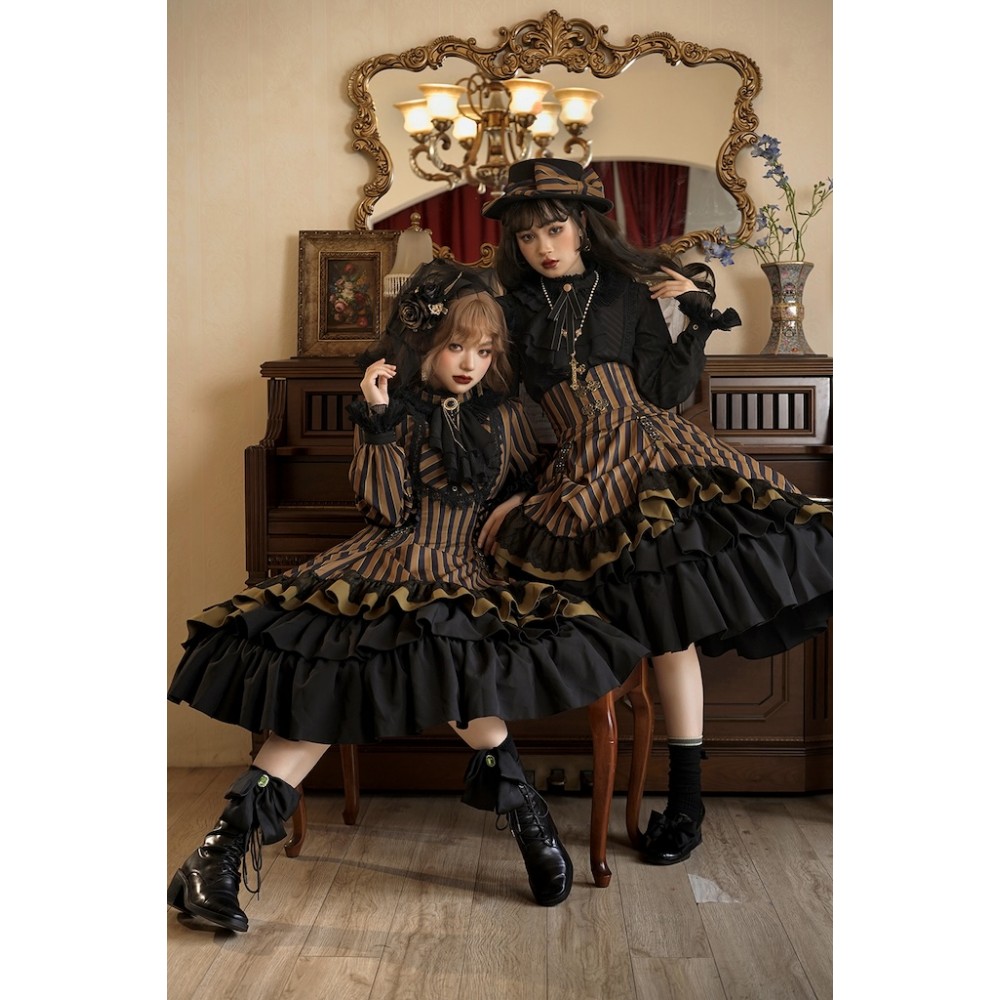
Defining Vintage in the Lolita Context
When we discuss vintage in the Lolita context, we refer to a specific era. Vintage lolita dress styles are not just old. They capture the essence of Lolita fashion from its early days. Think of dresses that possess styles from the 1980s to the late 1990s. This period marks the birth and adolescence of Lolita as a distinct style.
A vintage lolita dress involves more than age. It carries the intricate designs of bygone times. The fabrics, patterns, and craftsmanship are from the original Lolita era. These elements set them apart from modern interpretations. To be vintage, a dress often shows traditional techniques. It might have hand-stitching or handcrafted lace. These features contribute to the nostalgic feel of the garment.
Moreover, colors and prints play a significant role. Vintage designs favor pastels and muted colors. Classic prints include florals and stripes, true to the period’s aesthetic. The goal is to reflect a time when Lolita was still shaping its identity. It was an era of experimentation within style boundaries.
In essence, vintage is about authenticity and respect for the origins. When you wear a vintage lolita dress, you’re not just wearing an outfit. You’re embodying a piece of Lolita history. You honor the craftsmanship and artistry of initial Lolita creators. Vintage pieces thus hold special significance for collectors and aficionados.
Key Characteristics of Vintage Lolita Dresses
Vintage lolita dresses stand out due to their distinct qualities. Some key features define their timeless appeal. A true vintage lolita dress exemplifies the following characteristics:
- Complex Designs: Dresses often feature intricate patterns. Lace trimmings, ruffles, and multiple layers are common.
- High-Quality Fabrics: Makers used premium fabrics like cotton and silk for durability and comfort.
- Feminine Silhouettes: The dresses have a signature bell-shaped skirt. It creates a doll-like silhouette.
- Elaborate Detailing: Attention to detail is evident. This includes pintucks, smocking, and bows.
- Classic Motifs: The prints echo the past. Florals, stripes, and checks are popular choices.
- Subdued Color Palette: Unlike modern bright hues, vintage favors pastel and muted tones.
- Handcrafted Elements: Many vintage pieces showcase hand-sewn details, a nod to artisan skill.
These dresses capture a moment in time within the Lolita fashion scene. They bring history to life through fashion. Wearing a vintage lolita dress is more than a style choice. It is a way to connect with a fashion movement rooted in expression and elegance.
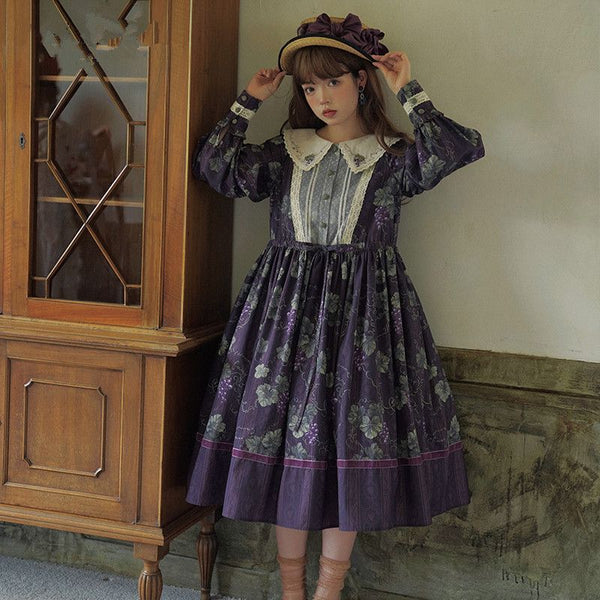
Popular Styles in Vintage Lolita Fashion
Exploring the various popular styles within vintage lolita fashion reveals a rich tapestry of designs. Each style stands as a testament to the era’s creativity. Here are some well-known styles that are emblematic of vintage lolita fashion:
- Classic Lolita: This style is the closest to Victorian-era clothing. It features longer skirts and high necklines, promoting a look of modest elegance.
- Sweet Lolita: Sweet Lolita is all about youthful charm. It uses plenty of pastels, lace, and ribbons to create a ‘cute’ aesthetic. Prints often depict themes like fruits, flowers, and fairy tales.
- Gothic Lolita: Gothic Lolita merges dark color schemes with the Lolita silhouette. Black lace, crosses, and dark jewel tones are hallmarks of this style. It’s a nod to the darker side of Victorian fashion.
- Punk Lolita: This style introduces an edge to traditional Lolita. It incorporates plaid patterns, chains, and leather, inspired by the punk movement.
- Country Lolita: With gingham prints and straw hats, Country Lolita embraces a rustic charm. It is less formal and ideal for outdoor gatherings.
- Old School Lolita: A term used by enthusiasts to describe the styles from Lolita’s early days. It includes simpler constructions and minimal layering.
Vintage lolita dress enthusiasts often mix elements from these styles to create unique looks. Each style allows wearers to celebrate different facets of vintage lolita dress aesthetics. These distinctions make the vintage lolita dress scene diverse and rich in history.
Where to Find Vintage Lolita Dresses
For enthusiasts keen to acquire a vintage lolita dress, there are several options. Understanding where to look can make the search easier and more enjoyable. Here are key places to find these unique garments:
- Second-Hand Stores: Thrift shops and consignment stores can be treasure troves. They may carry hidden gems from the Lolita fashion’s early days.
- Online Marketplaces: Websites like eBay and Etsy often list vintage Lolita dresses. Be sure to check the seller’s feedback for authenticity.
- Specialty Boutiques: Some stores specialize in Lolita fashion. They may have a selection of vintage pieces.
- Community Sales and Swaps: Lolita communities sometimes host sales or swapping events. These can be great places to find vintage items.
- Auctions: Occasionally, rare and highly sought-after vintage pieces come up for auction.
When searching for a vintage lolita dress, it’s important to verify authenticity. Look for signs of age, wear, and construction typical of the era. Be aware that sizes may differ from modern measurements. Always check the condition of the garment and ask for detailed photographs if shopping online. With patience and diligence, finding a vintage lolita dress that holds a piece of history is possible and rewarding.
How to Style a Vintage Lolita Dress
Styling a vintage lolita dress is an art that respects the tradition while allowing for personal creativity. Here are some tips to help you style your vintage lolita dress with elegance and authenticity:
- Start with the Basics: Ensure your dress is in good condition. A well-maintained vintage dress is essential for a polished look.
- Choose Appropriate Undergarments: A petticoat will give your dress the desired bell shape. Always opt for period-appropriate undergarments.
- Coordinate Colors Carefully: Match your accessories with the dress’s color palette. This creates harmony in your outfit.
- Select Suitable Footwear: Period-style shoes, like Mary Janes or Victorian boots, complement the vintage feel.
- Balance with Blouses: If your dress is a jumper skirt, pick a blouse that fits the era’s aesthetic.
- Layer Thoughtfully: Cardigans or boleros can add sophistication while keeping you warm.
By integrating these elements with your own taste, you’ll be able to create an outfit that’s both individualistic and sensitive to the vintage lolita dress style.
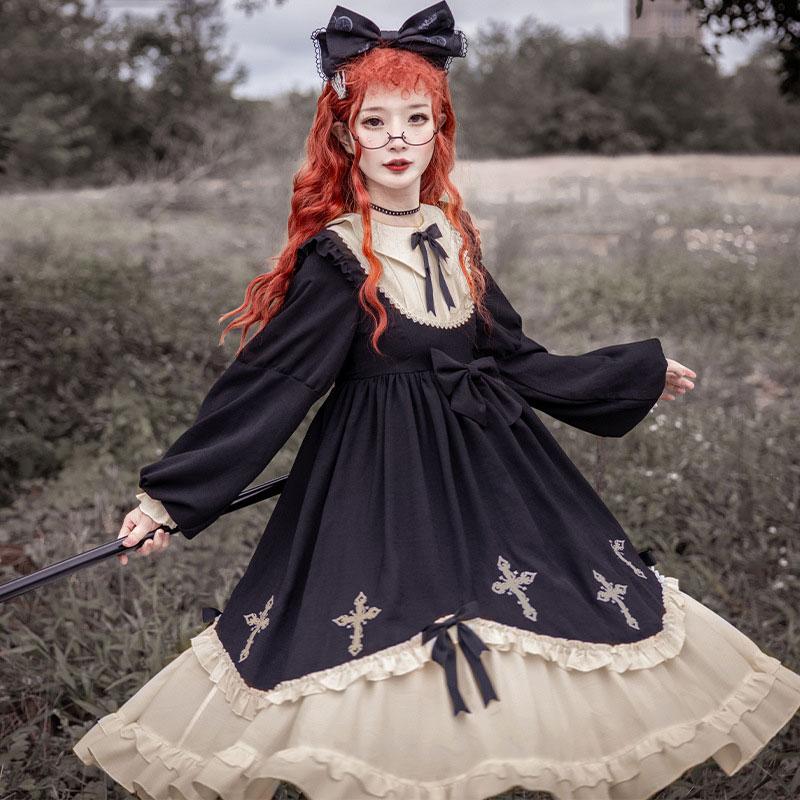
The Role of Accessories in Vintage Lolita Outfits
Accessories play a pivotal role in vintage lolita outfits, adding layers of detail that are both functional and aesthetic. Just like a vintage lolita dress, the accessories chosen must resonate with the time period from which the style originates, to ensure authenticity and depth in the overall look. Here are some accessory essentials that every vintage lolita ensemble should consider:
- Headdresses: Hair accessories such as bonnets, bows, and floral headbands, are staples in lolita fashion that crown the outfit with a touch of elegance.
- Jewelry: Vintage-style brooches, lockets, and cameos add a personal and classic feel that is understated yet poignant.
- Gloves: Lace or satin gloves can provide a finishing touch, bringing a sense of formality and grace to the ensemble.
- Bags and Purses: Small handbags or intricately designed purses are both practical and contribute to the thematic look.
- Footwear: The shoes should reflect the aesthetic, often including Mary Janes or Victorian boots that support the doll-like appearance.
- Hosiery: Patterned tights or knee-length socks often feature motifs in keeping with the dress, completing the outfit from head to toe.
Selecting the perfect accessories requires a keen eye for detail, a deep understanding of vintage aesthetics, and a personal touch. By carefully choosing each piece, you enhance the vintage lolita dress and pay respect to the timeless beauty that is Lolita fashion.
Maintaining and Caring for Vintage Lolita Wardrobe
Caring for a vintage lolita dress requires attention and detail to preserve its beauty and longevity. Here are practical tips for maintaining your vintage wardrobe:
- Handle with Care: Always be gentle when handling your vintage garments. Avoid rough treatment that can damage delicate fabrics or details.
- Washing Guidelines: Hand wash or use a delicate cycle on your machine. Use mild detergents and cool water to prevent fabric damage.
- Drying: Air dry your dresses away from direct sunlight. It avoids fabric weakening and color fading.
- Ironing: Iron on low heat settings. Use a protective cloth between the iron and the garment to avoid heat damage.
- Storing: Store your vintage dresses in a cool, dry place. Use padded hangers or archival garment boxes to prevent fabric stress and creases.
- Moth Protection: Use natural moth repellents like lavender sachets to protect fabrics from damage.
- Repairs: Tend to any repairs quickly. Small issues like loose seams or missing buttons can lead to bigger problems if ignored.
By following these care instructions, you can enjoy your vintage lolita dress for many years to come. Each piece in your lolita wardrobe is not just a garment but a cherished link to the past, deserving of the utmost respect and upkeep.
